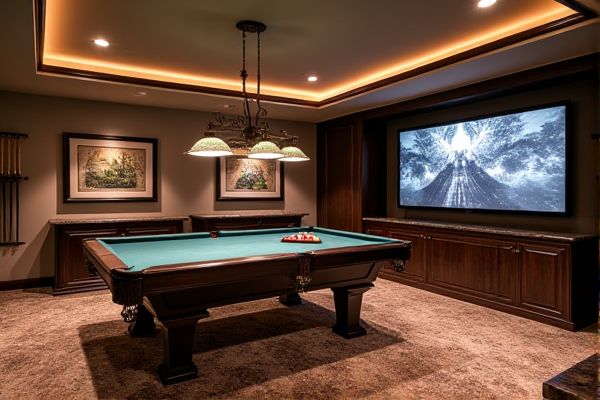
A billiard room is specifically designed for playing pool or other cue sports, often featuring a sturdy table and traditional decor, while a media room is optimized for watching movies and TV with comfortable seating and advanced audiovisual equipment. Discover which space best suits Your lifestyle by exploring the key differences detailed in the rest of the article.
Table of Comparison
| Feature | Billiard Room | Media Room |
|---|---|---|
| Primary Purpose | Playing billiards or pool | Watching movies, TV, and gaming |
| Key Equipment | Billiard table, cue sticks, balls | TV or projector, sound system, seating |
| Room Layout | Spacious for table and movement | Optimized seating facing screen |
| Lighting | Bright, overhead light focused on table | Dim or adjustable lighting for screen visibility |
| Acoustics | Basic acoustics, minimal soundproofing | Soundproofed or enhanced audio environment |
| Typical Users | Pool players, game enthusiasts | Film watchers, gamers, families |
| Design Style | Casual, social atmosphere | Comfort-focused, immersive experience |
Introduction to Billiard Rooms and Media Rooms
Billiard rooms are dedicated spaces designed for playing pool or billiards, often featuring custom tables, game accessories, and ambient lighting to enhance the gaming experience. Media rooms serve as home theaters or entertainment hubs equipped with large screens, surround sound systems, and comfortable seating to optimize movie watching and audio-visual enjoyment. Your choice between a billiard room and media room depends on whether you prioritize interactive gaming or immersive entertainment in your living space.
Purpose and Functionality Comparison
A billiard room is designed primarily for playing billiards or pool, featuring a spacious layout to accommodate the table and players, promoting social interaction and skill-based entertainment. In contrast, a media room focuses on audio-visual experiences, equipped with comfortable seating, a large screen, and surround sound systems for watching movies, gaming, or streaming content. Your choice depends on whether you prioritize interactive recreational activities or immersive entertainment in your home.
Design and Layout Differences
Billiard rooms are typically designed with ample space to accommodate a full-size pool table and allow for comfortable cue movement, often featuring durable flooring and minimalistic decor to prevent distractions. Media rooms prioritize acoustics and seating arrangements, incorporating soundproofing, tiered seating, and wall treatments to enhance audiovisual experiences. Your choice of design and layout depends on whether entertainment revolves around active gameplay or immersive viewing.
Essential Features of a Billiard Room
A billiard room requires a spacious layout with adequate clearance around the table, typically 5 feet on all sides, to allow comfortable cueing movements. Proper lighting, such as overhead pendant lights positioned directly above the table, ensures optimal visibility without harsh shadows. Durable flooring like hardwood or low-pile carpet and storage solutions for cues, balls, and accessories are essential for maintaining functionality and aesthetics in the space.
Key Elements of a Media Room
A media room centers around high-quality audio-visual equipment, including a large screen, surround sound system, and comfortable seating designed for extended viewing sessions. Proper soundproofing and controlled lighting enhance the immersive experience, making it ideal for watching movies, gaming, or streaming content. Your media room should prioritize technology integration and an acoustically optimized environment to deliver superior entertainment compared to a billiard room.
Entertainment Value: Which Room Suits Your Needs?
A billiard room offers interactive entertainment through games like pool and snooker, promoting social engagement and friendly competition ideal for gatherings. A media room, equipped with high-definition screens and surround sound, delivers immersive cinematic experiences perfect for watching movies, sports, or gaming. Your choice depends on whether you prefer active recreation or passive entertainment tailored to your lifestyle.
Space Requirements and Planning Considerations
Billiard rooms typically demand more open floor space, with at least 5 feet of clearance around a standard 9-foot pool table to allow comfortable cue strokes and player movement. Media rooms require careful acoustic planning and seating arrangement to optimize sightlines and sound quality within a generally smaller footprint. Your choice depends on prioritizing expansive, unobstructed space for gameplay in billiard rooms versus tailored spatial design for immersive audiovisual experiences in media rooms.
Cost Analysis: Setup and Maintenance
A billiard room typically requires a significant initial investment in quality tables, cues, and proper lighting, with ongoing maintenance including felt replacement and cue upkeep, potentially increasing long-term costs. A media room involves expenses for high-definition screens, sound systems, acoustic treatments, and comfortable seating, with maintenance mostly revolving around technology updates and potential repairs. Your choice depends on whether you prioritize durable, physical equipment or technologically driven components, influencing setup and maintenance budgets accordingly.
Social Interaction and Guest Appeal
A billiard room fosters social interaction through engaging, hands-on gameplay that encourages friendly competition and easy conversation. Media rooms create an immersive entertainment experience, drawing guests together for shared movie nights or gaming sessions. Your choice depends on whether you prioritize active social engagement or a cozy, collective media experience.
Choosing Between a Billiard Room and a Media Room
Choosing between a billiard room and a media room depends on your entertainment preferences and available space. A billiard room offers a classic, interactive experience focused on socializing and skill-based play, ideal for game enthusiasts, while a media room provides an immersive environment for watching movies, sports, and gaming with advanced audiovisual technology. Your decision should consider usage frequency, guest interaction, and desired ambiance to match your lifestyle and home design.
 homyna.com
homyna.com